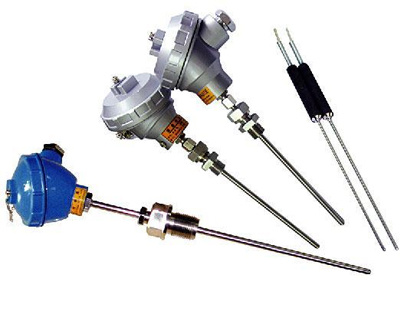
PT100 thermal resistance sensor for motors
The PT100 temperature sensor is an instrument that converts temperature variables into a transmittable standardized output signal. Mainly used for measurement and control of temperature parameters in industrial processes. A transmitter with a sensor usually consists of two parts: the sensor and the signal converter. The sensor is mainly a thermocouple or a thermal resistor; the signal converter is mainly composed of a measuring unit, a signal processing and a conversion unit (since industrial thermal resistors and thermocouple scales are standardized, the signal converter is also called Transmitter), some transmitters have added display units, and some also have fieldbus functions.
- Commodity name: PT100 thermal resistance sensor for motors
- 产品描述
- 产品规格及参数
-
The PT100 temperature sensor is an instrument that converts temperature variables into a transmittable standardized output signal. Mainly used for measurement and control of temperature parameters in industrial processes. A transmitter with a sensor usually consists of two parts: the sensor and the signal converter. The sensor is mainly a thermocouple or a thermal resistor; the signal converter is mainly composed of a measuring unit, a signal processing and a conversion unit (since industrial thermal resistors and thermocouple scales are standardized, the signal converter is also called Transmitter), some transmitters have added display units, and some also have fieldbus functions.
Temperature is one of the physical parameters that interacts most with humans in nature. Whether in production and experimental sites or residential and leisure sites, temperature collection or control is very frequent and important. Moreover, networked remote temperature collection and alarm are modern technologies. an inevitable trend of development. Since temperature is closely related to both the physical quantity itself and actual people's lives, temperature sensors will be produced accordingly. Due to the relationship between temperature and resistance change of PT100 thermal resistor, people took advantage of this characteristic to invent and produce PT100 thermal resistor temperature sensor. It is an intelligent sensor integrating temperature and humidity collection. The temperature collection range can be from -200℃ to +200℃, and the humidity collection range is from 0% to 100%.
If the PT100 temperature sensor is composed of two sensors used to measure the temperature difference, there is a given continuous functional relationship between the output signal and the temperature difference. Therefore it is called. There is a given continuous functional relationship (usually a linear function) between the output signal of the pt100 temperature sensor and the temperature variable. The output signal of the early produced pt100 temperature sensor has a linear functional relationship with the resistance value (or voltage value) of the temperature sensor. . The standardized output signals are mainly DC signals of 0mA~10mA and 4mA~20mA (or 1V~5V). Other standardized output signals with special provisions are not excluded. Temperature transmitters can be divided into two-wire systems and four-wire systems according to the power supply wiring method. The transmitters include electric unit combination instrument series, small modular type, and multi-functional intelligent type. The former does not have a pt100 temperature sensor, and the latter two types of transmitters can be easily combined with thermocouples or thermal resistors to form a sensor-equipped transmitter.

Overview
Pt100 and Pt1000 platinum thermal resistors are used as sensors for measuring temperature. They are usually used in conjunction with display instruments, recording instruments and control devices. The measuring range is -50℃~200℃. Thus realizing the whole process of temperature measurement, control and adjustment.
Features
It adopts thin film platinum thermal resistance elements imported from Germany, and the product quality reaches the IEC751 international standard. The resistance value of platinum resistors changes with temperature. The relationship between temperature and resistance is close to a linear relationship with minimal deviation and stable electrical performance. It is small in size, resistant to vibration, and highly reliable. It also has the advantages of precision, sensitivity, good stability, long product life, and ease of use.
working principle
The Pt100 platinum resistance temperature sensor uses the characteristic that the resistance value of platinum metal also changes when the temperature changes to measure temperature. The display instrument will indicate the temperature value corresponding to the resistance value of the platinum resistance. When there is a temperature gradient in the measured medium, the measured temperature is the average temperature in the medium layer within the range of the temperature sensing element.
Model example

order
When ordering, please specify the product model, temperature measurement terminal size, platinum thermal resistance graduation number, and lead length.
Special requirements shall be agreed upon by both parties.
For example:
WMZP-114, temperature measuring terminal Φ4×32, platinum thermal resistance graduation number Pt100, Pt1000 lead length 2500mm.
Technical data
model Temperature measurement range Graduation mark Accuracy level 0℃ resistance Thermal response time Insulation resistance WZP series -50℃~200℃ PT100 A 100Ω±0.06Ω 4~6 seconds ≥200MΩ B 100Ω±0.12Ω Temperature measuring end Material lead use length Specification Material Temperature resistant shield Φ3X16
Φ4X18
Φ4X32
Φ4X401Cr18Ni9Ti
stainless steelLead length user defined 3X0.2mm㎡
7/0.2F46 wire 200℃ Shielded or unshielded Motor winding temperature measurement Φ3X16
Φ6X38ceramics The sensor operating current should be ≤1mA
Dimensions example

Installation Notes
Install the sensor where the temperature needs to be detected (usually installed in the winding). Do not let the sensor lead bear tensile force. The lead should be connected to the motor junction box, and the shielded wire should be grounded (connected to the motor shell).
Key words:
PT100 thermal resistance sensor for motors
Product inquiry
Note: Please leave your contact information and our professionals will contact you as soon as possible!






